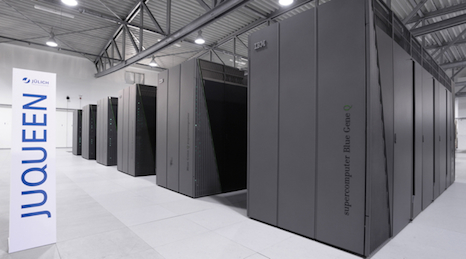 Germany is home to some serious computing power. Based on the November 2012 TOP500 list, three of the top ten European supercomputers are in Germany, including the number one, number two and number nine systems. Worldwide, these iron beauties clock in at fifth, sixth and 27th place, respectively.
Germany is home to some serious computing power. Based on the November 2012 TOP500 list, three of the top ten European supercomputers are in Germany, including the number one, number two and number nine systems. Worldwide, these iron beauties clock in at fifth, sixth and 27th place, respectively.
The German Gauss Centre for Supercomputing (GCS) owns and operates all three machines: JUQUEEN, the 5 petaflop IBM BlueGene/Q, installed at the Jülich Supercomputing Centre (number one); SuperMUC, the 3.2 petaflop IBM iDataPlex, housed at Leibniz Supercomputing Centre (LRZ) in Garching near Munich (number two); and HERMIT, the 1 petaflop Cray XE6 located at the High Performance Computing Center Stuttgart (number 9).
JUQUEEN is the first supercomputer in Europe to reach 5 petaflops of peak compute performance – roughly equivalent to the power of 100,000 PCs. The open science system, which is part of the PRACE pan-European research infrastructure, opens up new possibilities for grand scientific discoveries.
After an upgrade expanded the system from 8 to 24 racks, JUQUEEN moved up three spots from last June’s TOP500 list, while SuperMUC took two steps down. According to the Gauss Centre, HERMIT, which moved down three levels since the last list cycle, “continues to be the world’s fastest supercomputer used for industrial development, research and science.”
Like many of their American counterparts, the GCS directorate make it clear that while these systems are ranked based on the Linpack benchmark, their primary objectives are energy efficiency and sustained performance.
JUQUEEN, a BlueGene/Q supercomputer built on IBM POWER architecture, was designed to meet both these goals. With a performance/power ratio of approximately 2 Gigaflop/s per Watt, JUQUEEN is five times more energy efficient than its predecessor, JUGENE. A direct water cooling system that removes heat from the processors is part of the energy-efficient blueprint.
The machine’s 393,216 compute cores are tasked with solving a range of difficult problems as Prof. Thomas Lippert, Director of JSC, explains:
“JUQUEEN is targeted to tackle comprehensive and complex scientific questions, called Grand Challenges,” notes Lippert. “Projects from various scientific areas can profit from the system’s performance, e.g. in the areas of neuroscience, computational biology or energy and climate research. It enables complicated calculations in quantum physics, which were not possible before.”
The second-place European finisher SuperMUC was built with the same goals and is also exceptionally energy-friendly. Prof. Arndt Bode, director of LRZ, explains that hot-water cooling technology was key to achieving a PUE value of 1.1, a ratio that is unmatched among systems of similar performance, according to Prof. Bode.
And just as important, it was designed to be user-friendly. “We run more than 150 different applications on our system per year, thus an instruction set allowing easy adaption of user software was a core requirement on the system architecture,” says Prof. Bode.
All three GCS supercomputing systems are part of the German “Tier-0” research system and contribute to the European research infrastructure, the Partnership for Advanced Computing in Europe (PRACE). In total, the Gauss Centre for Supercomputing provides more than 9 petaflops of computing power to a wide array of research projects.
The top 10 European systems on the November 2012 TOP500 list.
1) JUQUEEN – Germany
Overall position: 5
Site: Jülich Supercomputing Centre
System: IBM Blue Gene/Q
Cores: 393,216
Linpack: 4.14 petaflops
Peak: 5.03 petaflops
2) SuperMUC – Germany
Overall position: 6
Site: Leibniz Supercomputing Center
System: IBM iDataPlex
Cores: 147,456
Linpack: 2.90 petaflops
Peak: 3.19 petaflops
3) Fermi – Italy
Overall position: 9
Site: CINECA
System: IBM BlueGene/Q
Cores: 163,840
Linpack: 1.73 petaflops
Peak: 2.10 petaflops
4) Curie thin nodes – France
Overall position: 11
Site: CEA/TGCC-GENCI
System: Bull Bullx B510
Cores: 77,184
Linpack: 1.36 petaflops
Peak: 1.67 petaflops
5) Blue Joule – UK
Overall position: 16
Site: Science and Technology Facilities Council – Daresbury Laboratory
System: BlueGene/Q
Cores: 114,688
Linpack: 1.21 petaflops
Peak: 1.47 petaflops
6) Tera-100 – France
Overall position: 20
Site: Commissariat a l’Energie Atomique (CEA)
System: Bull Bullx
Cores: 138,368
Linpack: 1.05 petaflops
Peak: 1.25 petaflops
7) DiRAC – UK
Overall position: 23
Site: University of Edinburgh
System: IBM BlueGene/Q
Cores: 98,304
Linpack: 1.04 petaflops
Peak: 1.26 petaflops
8) Lomonosov – Russia
Overall position: 26
Site: Moscow State University – Research Computing Center
System: T-Platforms T-Blade
Cores: 78,660
Linpack: .902 petaflops
Peak: 1.70 petaflops
9) HERMIT – Germany
Overall position: 27
Site: HWW/Universitaet Stuttgart
System: Cray XE6
Cores: 113,472
Linpack: .831 petaflops
Peak: 1.044 petaflops
10) Unnamed – France
Overall position: 31
Site: CNRS/IDRIS-GENCI
System: IBM BlueGene/Q
Cores: 65,536
Linpack: .690 petaflops
Peak: .839 petaflops



























































